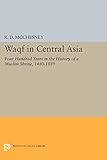Waqf in Central Asia : Four Hundred Years in the History of a Muslim Shrine, 1480-1889 / R. D. McChesney.
Material type: TextSeries: Princeton Legacy Library ; 1182Publisher: Princeton, NJ : Princeton University Press, [2014]Copyright date: ©1991Edition: Course BookDescription: 1 online resource (380 p.)Content type:
TextSeries: Princeton Legacy Library ; 1182Publisher: Princeton, NJ : Princeton University Press, [2014]Copyright date: ©1991Edition: Course BookDescription: 1 online resource (380 p.)Content type: - 9780691605449
- 9781400861965
- Charitable uses, trusts, and foundations -- Afghanistan -- Balkh Region -- History
- Islamic shrines -- Afghanistan -- Balkh Region -- History
- HISTORY / Middle East / General
- Abbasid Caliphate
- Abd Al-Rahman
- Abd al-Mu'min
- Abu Bakr
- Abu Talib ibn Abd al-Muttalib
- Abu Yazid
- Abu Yusuf
- Abu'l-Khayr Khan
- Ahab
- Ahl al-Bayt
- Ahmad Shah
- Al-Ghazali
- Al-Qastallani
- Al-Shahrastani
- Ali Mardan Khan
- Appanage
- Aqsaqal
- Ardabil
- Ashraf Ghani
- Atabeg
- Badakhshan
- Bahram (Shahnameh)
- Balkh
- Banna'i
- Battle of Khaybar
- Bayazid Bastami
- Bukhara
- Caliphate
- Central Asia
- Central Authority
- Dastur al-Muluk
- Deployment plan
- Dushanbe
- Emirate
- Foreign policy
- Hanafi
- Hegira
- Herat
- Hulagu Khan
- Ibn Battuta
- Ishmael in Islam
- Iskandar (Timurid dynasty)
- Islam
- Islamic culture
- Islamic state
- Ja'far al-Sadiq
- Kandahar
- Karbala
- Kashgar
- Khagan
- Khan (title)
- Khanate
- Khaybar
- Khoja (Turkestan)
- Kipchaks
- Majlis
- Maoism
- Mazar-i-Sharif
- Mihrab
- Mufti
- Muhammad Akram
- Muhammad Ishaq
- Muhammad Khan (Ilkhan)
- Muhammad Salih
- Muhammad al-Baqir
- Muhammad al-Shaybani
- Muhammad of Ghor
- Mukhayriq
- Murad Bakhsh
- Naqshbandi
- Oedipus complex
- Qadi
- Rabi' al-awwal
- Rustam (Haqqani network)
- Safavid dynasty
- Sahabah
- Samarkand
- Sayyid
- Shafi'i
- Shah Jahan
- Shahnameh
- Shahrbanu
- Shams al-Din Muhammad
- Sheikh
- Shia Islam
- Shrine of Ali
- Sufism
- Syncretism
- Tariqa
- Timur
- Transoxiana
- Turkistan (city)
- Umayyad Caliphate
- Uthman
- Uzbek language
- Uzbeks
- Waqf
- Yaqut al-Hamawi
- Zaidiyyah
- Zakat
- 297/.35 20
- BP187.55.A3 B345 1991eb
- online - DeGruyter
| Item type | Current library | Call number | URL | Status | Notes | Barcode | |
|---|---|---|---|---|---|---|---|
 eBook
eBook
|
Biblioteca "Angelicum" Pont. Univ. S.Tommaso d'Aquino Nuvola online | online - DeGruyter (Browse shelf(Opens below)) | Online access | Not for loan (Accesso limitato) | Accesso per gli utenti autorizzati / Access for authorized users | (dgr)9781400861965 |
Frontmatter -- Contents -- Preface -- Note on Transliteration -- Abbreviations -- Maps -- CHAPTER ONE. Introduction -- CHAPTER TWO. The Origins of the 'Alid Shrine at Balkh -- CHAPTER THREE. Waqf in Its Political Setting -- CHAPTER FOUR. Balkh, 1599-1647: Appanage Politics and the Growth of the 'Alid Waqf -- CHAPTER FIVE. Balkh and the Shrine, 1651-1681 -- CHAPTER SIX. The Evolution of the Shrine and Its Administration -- CHAPTER SEVEN. The Eclipse of the Appanage System: Balkh toward the End of the Seventeenth Century -- CHAPTER EIGHT. The Waqf Administration, 1668-1738 -- CHAPTER NINE. The Nadirid Occupation of Balkh, 1737-1747 -- CHAPTER TEN. The Consequences of Autonomy: The Emergence of a Shrine-State in the Century after 1747 -- CHAPTER ELEVEN. Shrine-State to Provincial Capital: The Muhammadza'i Mandate in Balkh, 1849-1889 -- CHAPTER TWELVE. Waqf under the Afghans -- CHAPTER THIRTEEN. Shrine-State to State Shrine -- CHAPTER FOURTEEN. Conclusions -- Glossary -- Bibliography -- Index
restricted access online access with authorization star
http://purl.org/coar/access_right/c_16ec
Waqfs, or religious endowments, have long been at the very center of daily Islamic life, establishing religious, cultural, and welfare institutions and serving as a legal means to keep family property intact through several generations. In this book R. D. McChesney focuses on the major Muslim shrine at Balkh--once a flourishing city on an ancient trade route in what is now northern Afghanistan--and provides a detailed study of the political, economic, and social conditions that influenced, and were influenced by, the development of a single religious endowment. From its founding in 1480 until 1889, when the Afghan government took control of it, the waqf at Balkh was a formidable economic force in a financially dynamic region, particularly during those times when the endowment's sacred character and the tax privileges it acquired gave its managers considerable financial security. This study sheds new light on the legal institution of waqf within Muslim society and on how political conditions affected the development of socio-religious institutions throughout Central Asia over a period of four hundred years.Originally published in 1991.The Princeton Legacy Library uses the latest print-on-demand technology to again make available previously out-of-print books from the distinguished backlist of Princeton University Press. These editions preserve the original texts of these important books while presenting them in durable paperback and hardcover editions. The goal of the Princeton Legacy Library is to vastly increase access to the rich scholarly heritage found in the thousands of books published by Princeton University Press since its founding in 1905.
Mode of access: Internet via World Wide Web.
In English.
Description based on online resource; title from PDF title page (publisher's Web site, viewed 27. Jan 2023)


